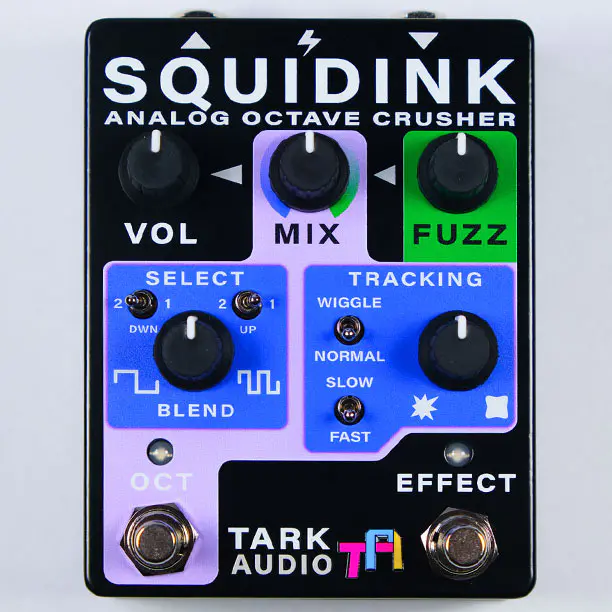
The Tark Audio Squidink is a multi-octave fuzz pedal made by a new company based in Portland, OR determined to create “products designed to help illuminate unexplored areas of sonic cartography.” Sounds intriguing…
The fuzz is a classic Fuzz Face-style circuit using low-gain Silicon PNP transistors.
The multi-octave section of the circuit, activated by a separate footswitch, is produced via an analog Phase-Locked Loop (PLL) circuit that gives you two blendable octave channels (one delivering -2 OR -1 octaves and the other one +1, OR +2 octaves). The resulting signal is – to use the builder’s own words – fed through a Voltage Controlled Amplifier (VCA) that is modulated by the envelope of the input signal, adding amplitude articulation to the octave signal.
Tracking is always a huge component of any pedal featuring pitch shifting, and although very efficient in this department, but the Squid Link goes one step beyond, opening up a few creative creative options related to this process: In Normal mode you can set up Fast or Slow tracking speeds via the toggle switch and the knob. In Wiggle mode, the circuit will add portamento (i.e glissando) between the notes, with the effect’s time set by those same controls.
The two circuits (fuzz and octaves) can then be blended to taste via the Mix knob.
Check out how this thing sounds in the video below.
Tark Audio Squidink, Builder’s Notes
SQUIDINK is a blend of a Fuzz and an analog Multi-Octave Generator. The Fuzz circuit employs a classic “Fuzz Face” topology using modern, low-gain Silicon PNP transistors. The FUZZ knob adjusts the gain of the fuzz circuit. The MIX knob controls the ratio of fuzz and octave signals. The VOLUME knob controls the output volume of the effect.
The analog Multi-Octave Generator uses a Phase-Locked Loop (PLL) circuit to output signals that are -2, -1, +1, and +2 octaves away from the input signal. The low and high octave selection switches select between the -2/-1, and +1/+2 octave sources, respectively. The OCT MIX knob controls the mix ratio between the high and low octave sources. The mixed octave signal is fed through a Voltage Controlled Amplifier (VCA) that is modulated by the envelope of the input signal. This amplitude shaping helps to add articulation to the octave signal.
The analog Multi-Octave circuit has multiple tracking options. In NORMAL mode, the TRACK knob and SLOW/FAST switch control the speed and character of the octave tracking. In WIGGLE mode, the octave signal portamentos to the target output frequency. The portamento time is controlled by the TRACK knob and SLOW/FAST switch. The octave signal can be enabled and disabled with the OCT footswitch. When the octave circuity is disabled, the MIX knob has no effect on the fuzz signal.
SQUIDINK has a high-impedance input buffer and a low-impedance buffered output. It implements relay controlled True-Bypass. It can be powered by a +9V to +18V, DC, center-negative voltage source and it consumes a maximum power supply current of 40mA.
Specs
- Operating Voltage: +9VDC to +18VDC
- Current Draw: 40mA (max)
- Input Impedance: 1 MOhm
- Output Impedance: 100 Ohm
- Bypass: Relay True-Bypass
- Dimensions: 3.7″ x 4.7″ x 2″
- Weight: 12.1 oz
- Jack Position: Top






















